
Unequaled Access to Care
EMS Receives Equipment to Boost Reliability and Safety
Working closely with other emergency response agencies, including police, fire, and 911, South Georgia Medical Center’s Emergency Medical Services (EMS) team members are often the first line of defense for patients.
To enhance the reliability and safety of EMS, SGMC invested $850,000 in its ambulance fleet. The project includes equipping every ambulance with a state-of-the-art power stretcher lift system.
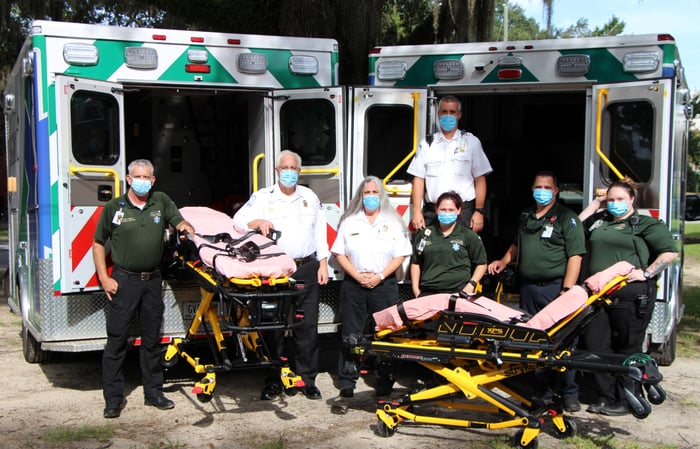
“This enhancement serves both patients and our medical professionals,” said SGMC Chief Nursing Officer Randy Smith. “The lifting system is designed with safety in mind and improves efficiency by safely lifting patients in a quick, smooth, and controlled action. Thereby reducing the risk of injury to our patients and medics.”
With 10 ambulances in its fleet, SGMC employs 73 medics who respond to emergency calls within a 1,200-square-mile region in Lowndes, Lanier, and Echols counties.
“Our top priority is the safety of our patients and staff,” said SGMC Chief Executive Officer Ronald Dean. “Our emergency medical professionals are at the forefront of the continuum of care and require the very best tools and equipment when responding to calls.”
Leveraging Technology via Apps. Communication continues to evolve and play a major role in health care. To facilitate this, SGMC offers three apps to the community.
MyChart
The MyChart application serves as your patient portal, allowing users to access their test results, manage their appointments, request prescription refills and communicate with their doctors.
SGMC App
The South Georgia Medical Center app serves as an extension of the SGMC website. This app is particularly helpful to stay up-to-date with the latest news from SGMC. Users can also quickly browse through physicians and learn about other services.
YoMingo
Whether this is your first pregnancy or third, YoMingo’s resources and tools will provide answers to many of your questions about pregnancy, labor and the birth of your child.

Residency Program
Creates Opportunities to Recruit Physicians to South Georgia
Pictured above : SGMC physicians joined SGMC and Mercer leadership at a joint press conference announcing the South Georgia Medical Center Mercer Residency Program.
Working to create a broader pipeline of doctors in Georgia, especially in rural communities, South Georgia Medical Center and Mercer University School of Medicine (MUSM) have established graduate medical education through a residency program in internal medicine.
"This partnership leverages the strengths of both organizations in developing a high-quality graduate medical education option for physicians seeking residency training in South Georgia," said SGMC President and CEO Ronald E. Dean. "As a teaching hospital, SGMC will couple academics with some of the best trained medical staff, nurses, and healthcare professionals within our highly capable health delivery system to advance our ability to better serve the healthcare needs of Valdosta, Lowndes County, and South Georgia."
Proud to partner with SGMC, Dr. Jean Sumner, Dean of MUSM, said, "The mission of MUSM is to educate physicians and health professionals to meet the primary care and healthcare needs of rural and medically underserved areas of Georgia."
Dr. Gregory Beale, director of the internal medicine residency program, said while the program is focused on recruiting residents from Georgia, it's also open to qualified candidates from medical education programs outside the state. SGMC is using the National Residency Matching Program to recruit physicians to its program.
Beale said it's focused on a "homegrown" approach of recruiting physicians to South Georgia. "If they are from Georgia and complete their residency here, there is a higher chance they will stay," he said. "We know from statistics that doctors normally go into practice within a 100-mile radius of where they finish their residency."
In January 2021, the internal medicine residency program received approval from the Accreditation Council for Graduate Medical Education (ACGME) and is on track to accept the first cohort of residents on July 1, 2022.
Subscribe for updates Never miss a beat.

Emergency Department Leadership
Focused on Patient Accessibility
For most hospitals, the emergency department (ED) is a hub of activity and often the front door for patient admission. Used for more than critical emergencies, a growing number of patients utilize the ED as the first point of contact with a doctor or mid-level provider.
To boost patient accessibility, in January 2020, South Georgia Medical Center’s ED partnered with South Georgia Emergency Medicine Associates (SGEMA) to provide leadership and increased physician services.
Led by Dr. Clark Connell, SGEMA provides Board Certified Emergency Medicine physicians with SGMC’s existing doctors and mid-level providers to offer emergency care to ill and injured patients.
“We bring more than 30 years of combined leadership and experience within the emergency room setting,” Connell said. “There is also an element of consistency. Our physicians are here day in and day out, not rotating in for a couple of weeks or months and then leaving. They live in the area and get involved, not just come in and work their shifts.”
Equipped to handle almost every type of critical and emergency situation, SGMC’s ED treats more than 80,000 patients a year.
Connell said, having the proper management and procedures in place ensures that all patients receive prompt treatment.
Focused on improving the department’s front-end process, Connell said, Tina Miller, Director of SGMC’s ED, has done an excellent job finding constraints in the patient-flow process.
“She has helped identify where those limiting steps are and helped us make corrections,” Connell said. “When patients walk through the doors, we look at how to decrease their wait time and get them back to see a doctor as quickly as possible.”
Miller said recognizing where there are inefficiencies and time constraints allows for greater patient care. “Now patients don’t sit in the lobby for a long time before they are seen. They come in and are registered, then see a nurse very quickly. The nurse starts the process of determining where the patient needs to go for appropriate care.”
Standard within most EDs is a triage system that places the critically ill or injured patient as a priority for medical treatment.
“We do a tremendous job at triaging critical patients,” Connell said. “The challenge comes when patients are not severely injured or sick. A sprained ankle, sore throat, or rash are conditions that historically had to wait while we cared for more critical patients. We have recently put in a process that allows us to see these lower-acuity patients almost as fast as the more serious patients.”
Streamlining resources and bridging relationships with other hospital departments have helped improve efficiency and quality of care.

“We are also processing some tests within the ED,” Connell said. “Tests that we used to send to the lab, like pregnancy, are now done here, which gets us test results back in five minutes instead of 60 minutes.”
Another goal is to lower the number of patients that leave without seeing a provider. “As we improve our processes, the number of patients that leave without being seen by a provider has dropped from 14 percent, three years ago, to less than 2 percent.”
Striving for long-term wellness, Connell said, “As physicians, it’s our responsibility to help people get better and stay better. Sometimes that means identifying a problem and directing them to the right medical care.”
More than dealing with the acute medical issue, Connell said it’s easy to deal with the critical problem and not the associated chronic issues. “For example, in South Georgia, there are high numbers of people who have uncontrolled hypertension, diabetes, and COPD [Chronic Obstructive Pulmonary Disease], you name it—all of these lead to bigger issues.”
For long-term wellness, patients, especially those with underlying medical conditions, need access to a primary care physician or mid-level provider.
“Part of what we are doing is making sure patients are connected to a doctor, someone who will monitor their chronic issues. This keeps them from coming back to the emergency room. We are not here just to take care of people when they are injured or need immediate assistance. We want to be part of the bigger solution of providing the best healthcare options for longterm results.”
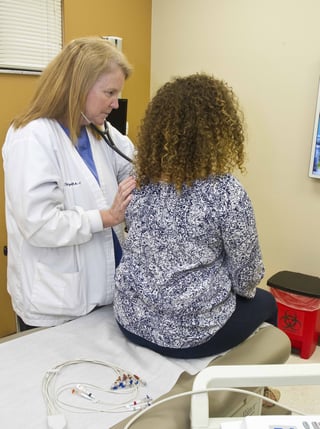
Working to Create More Healthcare Access
The Partnership Health Center (PHC) opened in 2007 to provide primary healthcare access for uninsured adults (18 to 64 years old) with incomes below 300 percent of the federal poverty level guidelines.
The PHC medical staff includes three full-time and four part-time midlevel providers, delivering primary and preventive care, chronic disease management, urgent care, dental, and pharmaceutical services to economically disadvantaged adults.
In the past 14 years, PHC has expanded its operation from one small facility with a limited staff to three buildings— including a dental clinic—and 35 employees.
The center is supported financially through an annual grant from South Georgia Medical Center, corporate and individual donations, and a nominal ($10 to $20) patient charge per visit.
In 2020, the PHC provided 15,363 in-person and telehealth visits and distributed more than $13 million in free medications.
“The free medicine distribution is done through the pharmaceutical manufacturers,” said John Sparks, PHC Director. “We might have a patient that makes $14,000 a year, and their insulin cost is $10,000 annually. They don’t buy it, and then they end up getting sick and in worse shape.”
Sparks said PHC is grateful to SGMC for its continued financial support, which has been instrumental in expanding healthcare access to more uninsured adults in South Georgia.
“SGMC has been a supporter of the Partnership Health Center since we started,” Sparks said. “The hospital’s assistance has allowed us to hire more mid-level providers and open the clinic seven days a week.”
Sparks explained that SGMC provides more than financial support. “When a patient, who is eligible for services, is discharged from the hospital, a case manager automatically refers them to the clinic for follow-up appointments.”
For SGMC, it is a positive return on investment. “Most uninsured adults don’t have a primary care doctor,” Sparks said. “If they don’t receive medical followup care, they are going back to the hospital. The biggest problem is they are in jeopardy of being in worse shape without their medication and other treatments.”
Whether traditional in-person or telehealth visits, studies have shown that patients who don’t receive follow-up care are at higher risk of returning to the hospital.
Partnership for Health provides telehealth appointments—via telephone and live audio-video—to accommodate more patients, especially for the management of chronic health conditions.
“Before COVID-19, we were already using telehealth. When the pandemic hit, telehealth was in our wheelhouse, and for a while, all appointments were telehealth visits.”
Telehealth visits are provided at no charge, and the response from patients has been positive. “Most people like telehealth because they routinely talk to the same provider each time and build a relationship,” Sparks said. “It might seem a little bit strange at first, but then they realize they are getting the same care.”
According to Sparks, about 60 percent of health issues are solved via telehealth appointments. “This makes us far more efficient in using our limited scheduling spots.”
There is still a tremendous need to expand the clinic’s services. In Lowndes County, more than 25,000 people are qualified to use PHC services.
“Without follow-up care, most people are at a high risk of getting worse and returning to the hospital,” Sparks said. “If we can get them to the clinic and make sure they have their medication, then we can help keep them from going back to the hospital.”

Physician Network Growth.
A year of monumental growth.
This year proved to be one of monumental physician growth at SGMC. The organization officially established the SGMC Physician Network and made physician relations, support, and growth a major priority.
In the specialty arena, SGMC welcomed physicians in neurosurgery, neurology, infectious disease, gastroenterology, cardiology, and pulmonology.
View a complete list of SGMC’s Physician Network providers and our 400+ Medical Staff.
Meet Some Of Our Physicians
Providing a Solid Foundation for Women’s Healthcare


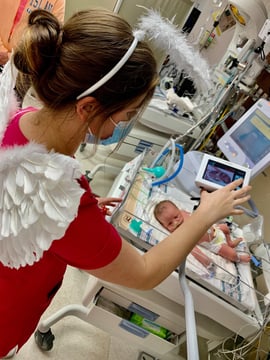
South Georgia Medical Center is committed to providing preventive women’s healthcare services, disease-fighting treatments, diagnostic testing, and education.
Building on its solid foundation of providing the highest-quality healthcare for women, plans are underway to create a new Women and Infant Center.
“We are laying the foundation for the new center by implementing programs and expanding technology within women’s health and labor and delivery,” said Randy Smith, SGMC Chief Nursing Officer and Chief Operating Officer. “Women can stay here in our community to receive the highest level of care for labor and delivery and overall women’s health issues.”
While reviewing women’s healthcare needs, Smith said SGMC is using a systematic approach. “It’s more than just adding or upgrading technology,” he said. “We are examining the needs of our patients and demand for services.”
One of the first initiatives includes the purchase of 3D Hologic Genius™ Mammography™ machines.
“These are the best in class for breast imaging,” Smith said. “By upgrading to 3D mammogram imaging, it allows us to advance our diagnostic abilities and provide advanced care for women with breast imaging needs.”
The Birthplace
The Birthplace at SGMC welcomes more than 2,000 babies to Lowndes County and surrounding communities each year.
With a team of 13 obstetricians, two neonatologists, four midwives, and a dedicated staff of nurses and healthcare professionals, when the “big day” arrives, SGMC’s Birthplace is ready.
A regional leader in labor and delivery services, SGMC has recently invested in several enhancements that benefit both expecting mothers and babies.
SGMC is also equipped with a Level IIB Neonatal Intensive Care Unit (NICU) that includes board-certified neonatologists to provide a higher level of care for babies born prematurely.
For expecting mothers, Smith said SGMC is working toward adding women’s care coordinators. “These positions will serve as navigators to help moms and the entire family prepare before the birth takes place.”
OB Hospitalists
SGMC recently launched its Obstetrical Gynecology (OB/GYN) Hospitalist Program and Obstetrics Emergency Department to provide 24/7 in-hospital OB/GYN availability.
“Adding the OB Hospitalist Group program to SGMC’s healthcare team represents a significant investment in our health system,” Smith said. “It offers an elevated standard of care for our patients and positively impacts the lives of women, their babies, and the families we are privileged to serve.”
The board-certified OB hospitalists remain in the hospital 24/7. They provide coverage in labor and delivery and offer a dedicated OB Emergency Department, where expecting mothers can receive an examination at any time, day or night, by an obstetrician. Not just for labor and delivery, OB hospitalists are available for gynecological emergencies.
OB hospitalists enhance care and safety for pregnant patients but do not replace their regular obstetrician care. When an emergency intervention is needed or unexpected delivery occurs, the OB hospitalist is positioned at the hospital to ensure quality, timely care.
“Any mother that comes in and doesn’t have an assigned obstetrician, an OB hospitalist will be here for them,” Smith said. “If the mother has an assigned obstetrician, then the hospitalist will do the medical screening and examination, and then follow-up with their doctor.”
According to Peggy Knight, RN, Administrative Director of SGMC Women and Children Services, when a patient comes to the Emergency Department, they go straight to labor and delivery if they are more than 20 weeks pregnant.
“The former process included a medical screening by a nurse,” Knight said. “Now pregnant women are examined by an OB hospitalist, who determines if she needs to stay, receive treatment, or is in labor.”
The 40 weeks leading up to a baby’s birth can be a time of great joy and anxiousness. Expectant mothers need to understand what’s happening before, during, and after delivery.
SGMC has invested in numerous labor and delivery enhancements in the past year, including advanced technology to provide added comfort for mothers and babies.
Pregnancy App
From their smartphone, pregnant women can download the YoMingo app, and access information and resources focused on prenatal care, labor, delivery, postpartum, breastfeeding, and newborn care. The app also features a kick counter tool, contraction timer, measurement counter, and more.
AngelEye
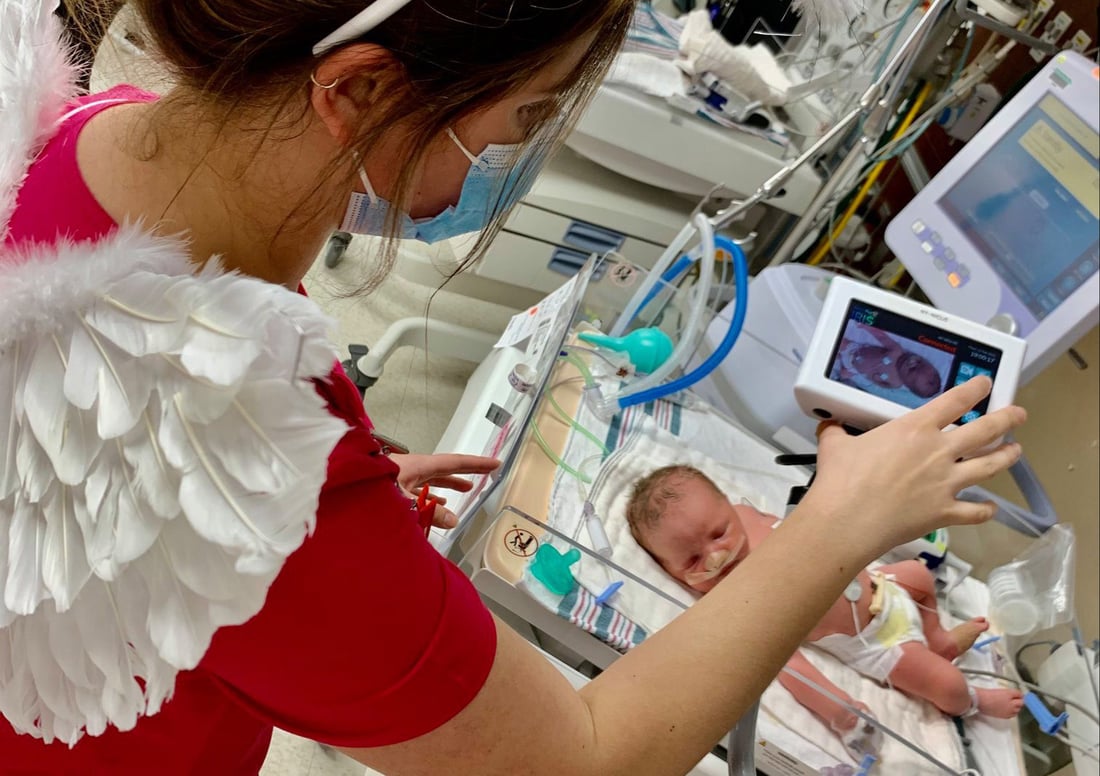
Promoting a greater focus on technology that positively enhances the patient’s family members’ connection to their newborns.
SGMC is one of only three hospitals in Georgia to offer the AngelEye Health system. With advanced camera technology, AngelEye allows nurses to send text messages, photos, and videos.
“Family members can register to see the mom and baby during delivery and afterward,” Knight said. “It’s a secure system with a password, and the images are erased every 24-hours.”
The AngelEye Health system is especially beneficial in the NICU when mothers are discharged and newborns need to remain at the hospital. The AngelEye technology allows parents and registered family members 24/7 visual access to the baby.
“It also benefits military families,” Knight said. “If we have a mom delivering and the father is deployed, we can place a camera on the mother’s waist, pointed toward her face so that the father can see the baby placed on the mother’s chest.”
Wireless Monitoring
SGMC’s Birthplace has added wireless fetal monitors that safely give mothers more freedom to move around during the labor process. “The bulky belt monitors were cumbersome, and if the mother moved, even slightly, they would have to be readjusted,” Knight said. “The wireless monitors keep the mothers from being confined to the bed. They can walk around the room or down the hall, even take a shower.”
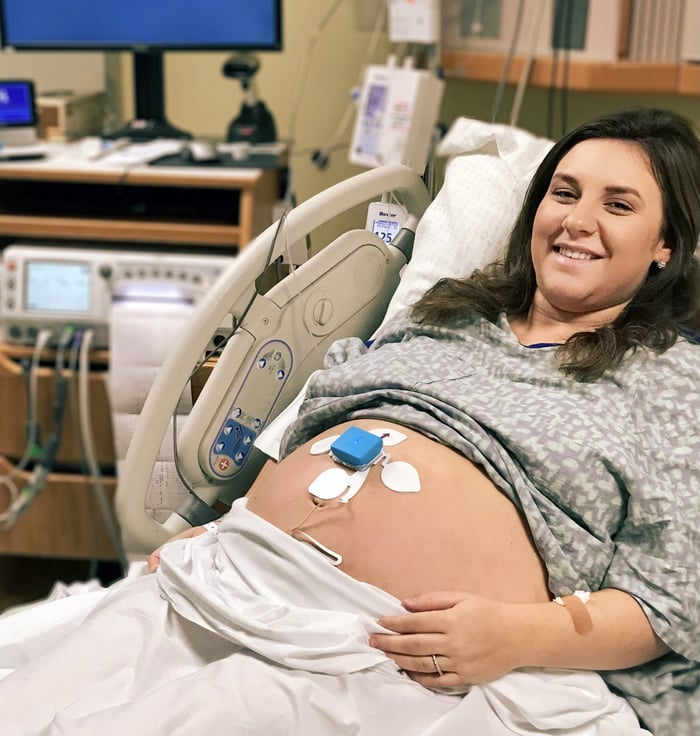
“The wireless monitors keep the mothers from being confined to the bed. They can walk around the room or down the hall, even take a shower.”
Birthing Beds
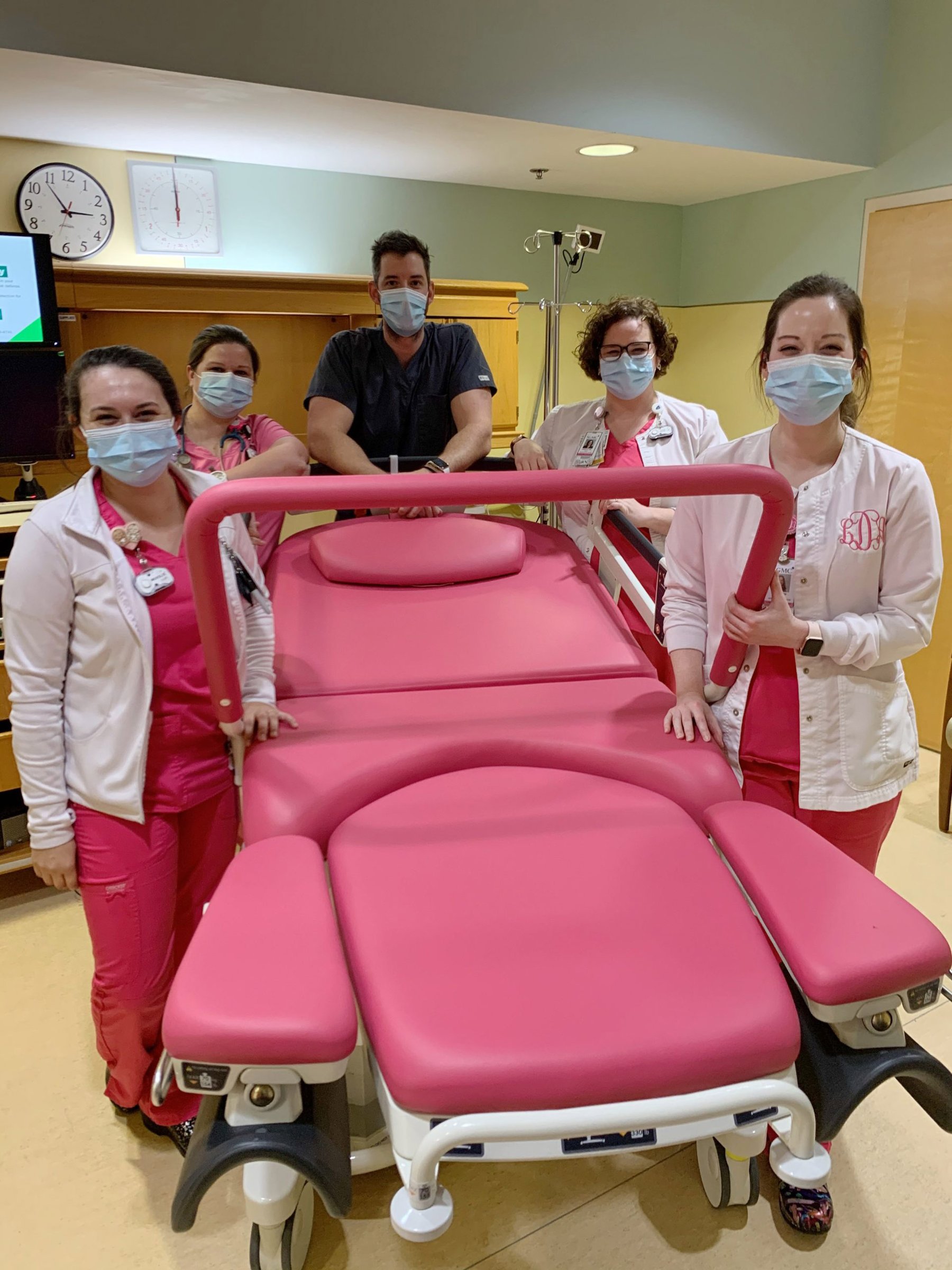
One of the many upgrades within labor and delivery includes new birthing beds, which bring a higher comfort level and efficiency to the labor experience. The high-quality birthing beds are suitable for labor, delivery, recovery, and postpartum.
Knight said they are the “Cadillac of birthing beds,” and the additional features make the labor and delivery process easier for both mothers and their providers.
SGMC’s new programs and equipment reinforce the hospital’s commitment to the labor and delivery experience and overall women’s healthcare.
“When you look at best practices for women and children’s services, SGMC continues to add elements that are needed for quality and safe care,” Smith said. “All of these programs and advanced technology are needed now, and they are part of our ultimate goal of moving us toward the creation of new the Women and Infant Center.”
Subscribe for updates Be the first to know.
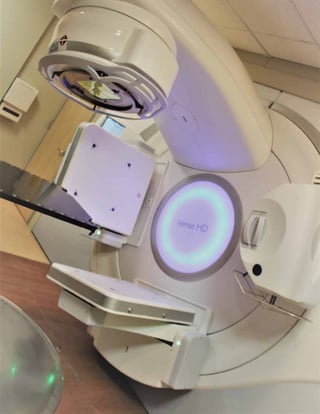
Cancer Center Invests in New Linear Accelerators
South Georgia Medical Center recently completed a $6 million upgrade of its two linear accelerators. Located in the Pearlman Cancer Center, the versatile linear accelerators deliver customized external beam radiation treatments to cancer patients. These units are an essential part of cancer treatment with two-thirds of Pearlman’s patients receiving radiation therapy at some point during their care.
Dr. John Devine, Medical Director for Radiation Oncology, said, “The Elekta Versa HD linear accelerators provide additional capabilities, such as stereotactic radiosurgery, volume modulated arc therapy, and surface guided radiation therapy including deep inspiration breath hold.”
Stereotactic radiosurgery (SRS) ensures high definition dynamic treatment of complex or challenging cancers with submillimeter accuracy. Volume modulated arc therapy (VMAT) speeds up the treatment delivery time.
The new accelerators use Vision RT Surface Guided Radiation Therapy (SGRT), a technique that includes a three-dimensional camera system to project a laser map on the patient’s skin surface to detect any position changes during treatment. When movement is detected, the accelerator automatically pauses the radiation treatment.
“The goal is to treat the tumor with a high dose of radiation while protecting the surrounding vital organs and tissues”
According to Shahidul Pramanik, Medical Physicist, the upgrade took approximately a year to complete. Each accelerator weighs nearly 9 tons and is housed separately in a specially constructed vault. An upgrade of this magnitude is needed every 10-12 years, which is the expected life-span of the sophisticated equipment.
“At the center of every cancer fight is a patient,” said Laura Jones, Chief Therapist and Dosimetrist. “It’s always exciting to have the most advanced technology to offer our patients, because they are our friends and family.”
Janna Luke, Director of the Pearlman Cancer Center, said, “We pride ourselves in being the region’s leader in comprehensive cancer care. This investment further supports that mission as patients can receive the latest and greatest cancer treatment closer to home.”
Pearlman serves a 15-county area, treating nearly 2,000 patients each year. Pearlman has performed approximately 100,000 treatments through the linear accelerator and more than 250,000 radiation oncology procedures in the last decade. The center is accredited by the American College of Surgeons Commission on Cancer and the American College of Radiology.
Purchase of the linear accelerators was made possible by the philanthropic support of the SGMC Foundation.



